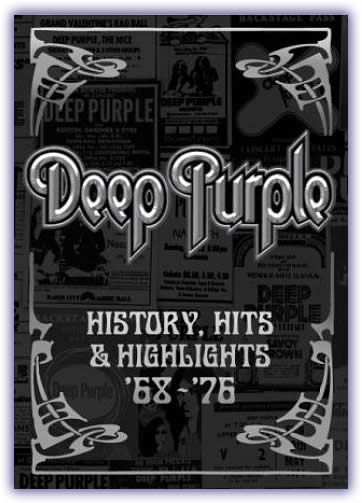| Deep
Purple - History, Hits & Highlights: ‘68-‘76 |
By
Jason Marks

Deep Purple - History, Hits & Highlights: ‘68-‘76 Eagle Rock, 2009
Even the casual rock fan knows Deep Purple, if only
for the opening chords of one of the most famous riffs
in all of rock and roll – “Smoke on the
Water,” whose “duh-duh-duh duh-duh-da-duh”
has perhaps only two rivals as ubiquitous in the popular
culture – “Satisfaction” by the
Rolling Stones and “Pinball Wizard” by
The Who. But Deep Purple has been so much more than
this famous riff, a band of astonishingly talented
musicians who took the blues, classical music, Renaissance
melodies and traditional rock and jazz rhythms and
mixed them together to form one of the archetypes
of progressive hard rock. To celebrate the 40th anniversary
of the band, Eagle Vision has released a 2 disc DVD
set entitled “History, Hits & Highlights:
’68-‘76” – a lengthy (over
4 hours) package of the formative years of the band,
a mixture of documentary material , rare videos and
live concert footage.
Few bands still talked of so frequently, let alone
touring and recording, forty years after its start
have had as many lineup changes and drama as Deep
Purple. In fact, quite a bit of the infighting mocked
in “This is Spinal Tap” come from stories
based on the band, mixed with those of Led Zeppelin,
Black Sabbath and the Beatles. Formed in 1968 by guitar
virtuoso Ritchie Blackmore, keyboard magician Jon
Lord and drummer extraordinaire Ian Paice, the band
sought to create a harder edge version of then-popular
band Vanilla Fudge. The MK1 lineup was completed with
the addition of bassist Nick Simper and singer Rod
Evans. The early hits “Hush” and “Kentucky
Woman” gave Deep Purple an international audience
and, ironically, an inaccurate representation of the
group’s music which onstage tended toward lengthy
jams and challenging interplay between Blackmore and
Lord. “History” gives some rare footage
of the MK1 lineup, including some rather amusing clips
from the Playboy Club, complete with a Hugh Hefner
introduction! Within a year, in an attempt to create
a more hard rock sound, Simper and Evans were out,
replaced by vocalist Ian Gillan and bassist Roger
Glover, completing the classic MK2 lineup that would
record the groundbreaking albums “In Rock,”
“Fireball,” and “Machine Head.”
The footage on “History” from this era
is extensive. Some has been released previously, but
the unreleased tracks, including very lengthy versions
of Mandrake Root and Wring That Neck, both in black
and white, showcasing the amazing fretwork of Blackmore.
We also get a peek into recording sessions for Fireball,
a true historical bonus for long-time fans. The rapid
success of the classic lineup, including an entry
into the Guiness Book of World Records as the world’s
loudest band, non-stop touring and youthful egos led
to the departure of Gillan and Glover, replaced by
vocalist David Coverdale and bassist Glenn Hughes.
The MK3 lineup took a slightly funkier and more experimental
turn on the “Burn” and “Stormbringer”
albums. “History” features strong performances
of “Burn” and “Mistreated”
but I would have liked to have seen more of this lineup.
Interested fans should look for the California Jam
DVD to see this lineup and a finale that shows Blackmore
blown off the stage when he set his guitar on fire.
The funk direction led Blackmore to leave, and the
band chose to carry on with Tommy Bolin as the new
guitarist. The product of MK4, “Come Taste the
Band,” has a lot of great music, just not necessarily
in the Deep Purple vein, but rather foreshadowing
what Whitesnake would sound like in two years. “History”
has a wonderful performance of “You Keep on
Moving” – perhaps the best song from this
short-lived lineup, which came to a tragic end with
the drug overdose of Bolin.
Deep Purple MK2 reunited in 1984 and recorded three
albums into 1993, until Blackmore again left, this
time for good. The band found a replacement in Steve
Morse and has carried on continuously to today, with
only one additional tweak – the retirement of
Jon Lord in 2005 replaced by Don Airey. Interested
fans can find many DVDs of the Morse era, which I
find enjoyable even as a total Blackmore devotee.
Deep Purple has never received the credit they deserve
for their pathbreaking contributions to hard rock.
Musicians regularly acknowledge Blackmore for his
guitar work, and I think he is the most imitated guitarist.
Hopefully, the Rock and Roll Hall of Fame will follow
the pleadings of Metallica’s Lars Ulrich and
recognize this great band.
The DVD set “History” certainly offers
quality and quantity, but it is not marketed to either
the die-hard fan or the casual fan. The documentary
beginning is too little for the casual fan; some of
the previously released material unnecessary to the
die-hard fan. The packaging is beautiful and the liner
notes extensive and revealing. The remastered sound
quality is solid and consistent. A must for the true
fan, and a joy ride for the uninitiated.
 |
|
|
